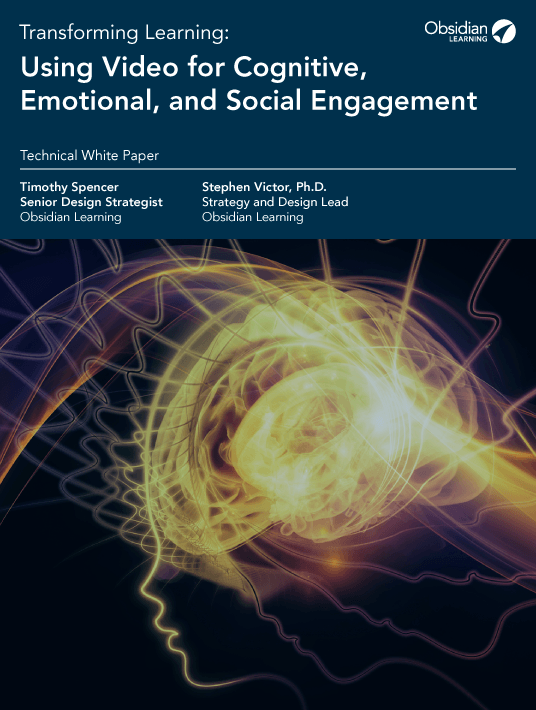Transforming Learning: Using Video For Cognitive, Emotional, And Social Engagement
Whether video can be effective for instruction is one of the questions that Transforming Learning: Using Video For Cognitive, Emotional, And Social Engagement sets out to answer, starting out with an examination of cognitive theories of learning and their application in creating effective instructional video. The theoretical aspects of the eBook are complemented by practical guidelines for the design and development of instructional videos, including a list of software tools that Obsidian Learning uses in its day to day work, and a case study that spotlights the development of a superb communications piece titled “Learning is Life.”

The eBook begins with a discussion of cognitive learning theories, which examine the how human beings process information. As the eBook points out, “when we receive external data, our minds process it, discard it, or store it.” Some explanations for how it does so are provided by dual coding theory, cognitive load theory, and the cognitive theory of multimedia learning. The discussion of these theories provides an excellent basis for reflection; after all, understanding how our brains work is the first step toward developing effective Instructional Design strategies to improve assimilation of information.
Cognitive Theories And The “Whole” Learner
Application of the cognitive theory of multimedia learning has resulted in the development of a design model known as “SSW” – segmentation, signaling, and weeding. Segmentation involves “chunking” information, signaling relates to providing viewers with cues pertaining to the structure of the content, and weeding is the removal of non-essential content. Instructional Designers, whether consciously or not, use these types of strategies in instructor-led training, and it makes sense that they would apply equally as effectively in video.
Transforming Learning: Using Video For Cognitive, Emotional, And Social Engagement also explores the notion of the “whole learner”, expanding upon the complexity of the learning process and how receptiveness to instruction is affected by learners’ cognitive, emotional, and social characteristics. Examining the whole learner is just one step removed from examining a holistic approach to learning that is defined by the three dimensions of content, incentive, and interaction.
The discussion on cognitive theories of learning and the whole learner is a prelude to a more concrete look at how video can be applied in instruction. As the eBook points out, video can be used to “explain and simplify complex concepts, systems, or processes.” It is well-suited for mobile learning and particularly useful for what is termed “video feedback” (filming oneself performing a task and reviewing the video to evaluate performance). It can also be used to teach psychomotor skills (see the discussion on filming perspective), and can be a replacement for in-person observation course requirements. Video is useful across a variety of industries, and examples are provided of applications in fields as diverse as healthcare, law enforcement, industrial health and safety, and construction.
Creating Effective Instructional Videos
At this point Transforming Learning: Using Video For Cognitive, Emotional, And Social Engagement links back to the theoretical discussion; using cognitive learning theories as a guide, the authors provide a clear blueprint for creating effective learning videos. They provide advice on video length, filming perspective, imagery and related voice over, visual cues, search and navigation tools, and associating content with emotion. This is followed by a list of “tips and tricks” that Obsidian Learning employs for in-house video production. This section provides invaluable pointers on elements such as theme, framing, transitions, tone, workflow and visual devices.
The eBook then directs its attention toward the more specific topic of video animation. This section is a particularly rich resource, describing various motion design techniques, animation terminology, and outlining the features of the latest animation, graphics, video editing, sound editing, and storyboarding software.
Finally, the authors provide a window into Obsidian Learning’s video development process. The first steps (information gathering, instructional design, storyboarding, visual design) align fairly closely with the development of most learning deliverables. Video, however, requires a few extra steps, notably first draft and final draft animation.
The eBook winds down with a case study involving the creation of a video titled “Learning is Life”. This visually stunning animated piece was created for a 2016 conference, and readers are offered an inside look at its design and fabrication, from concept to finished piece.
Starting with the presentation of cognitive learning theories and how they can be applied in instructional video design, and followed up by resources including best practices for the creation of such videos, descriptions of software tools, and guidelines for video design and development, Obsidian Learning’s eBook Transforming Learning: Using Video For Cognitive, Emotional, And Social Engagement provides a thoughtful, well-researched roadmap for using video to greatest effect for instructional purposes.
Related articles:
1. 5 Stages Of Instructional Video Development Process – Feat. A Case Study
2. Software Tools For Instructional Video Design And Development
3. 6 Top Tips To Design Effective Instructional Videos
4. Transforming Learning: Applications Of Instructional Videos








